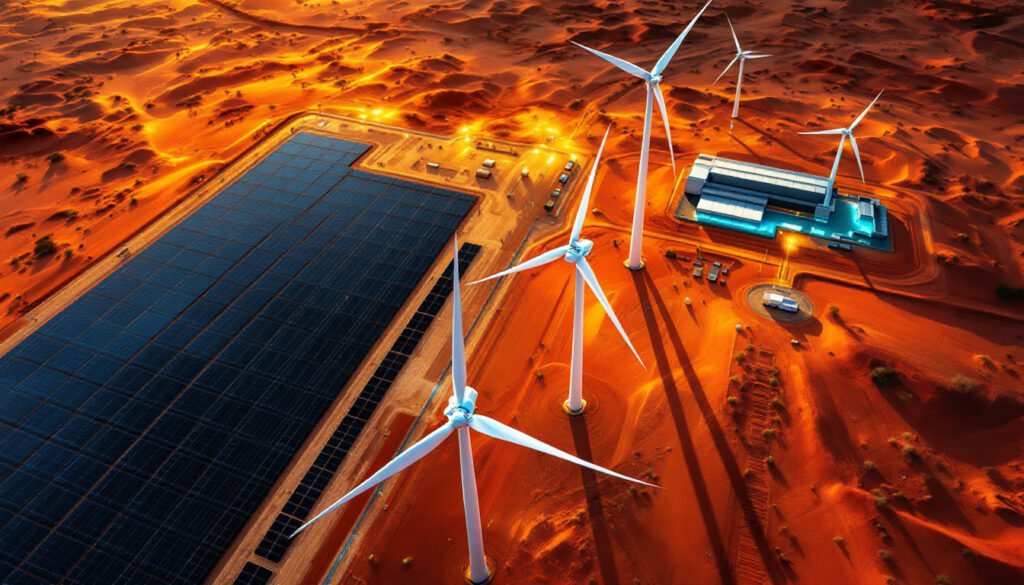AngloGold Completes 115MW Hybrid Power System: Australia's Largest Mining Renewable Energy Project
AngloGold Ashanti has successfully commissioned Australia's largest hybrid renewable energy system in the mining industry, marking a significant milestone in the sector's transition to sustainable power solutions. The 115MW system at the Tropicana Gold Mine in Western Australia represents a groundbreaking achievement that combines thermal generation with cutting-edge renewable technology, setting new benchmarks for the mining industry decarbonisation efforts.
The completion of this project demonstrates how traditional mining operations can effectively integrate large-scale renewable energy systems while maintaining operational reliability in remote locations. This innovative approach not only reduces environmental impact but also enhances energy security and operational economics.
What is AngloGold's Tropicana Renewables Project?
The Tropicana Renewables Project represents a transformative approach to powering remote mining operations in Australia. Located approximately 330km northeast of Kalgoorlie in Western Australia, this innovative power system has been designed to dramatically reduce the mine's carbon footprint while ensuring reliable power supply.
The project forms part of AngloGold Ashanti's broader strategy to reduce its environmental impact across global operations, combining multiple renewable technologies with conventional power generation to create a resilient and efficient energy system.
Overview of the Hybrid Power System
The 115MW total capacity hybrid power system seamlessly integrates thermal and renewable energy sources, with 61MW of clean energy incorporated into Tropicana's existing power infrastructure. This makes it the largest hybrid power system in Australia's mining industry, demonstrating the potential for renewable integration in remote industrial operations.
Designed and operated by Pacific Energy under a ten-year power purchase agreement, the system represents a significant engineering achievement. The hybrid approach ensures reliable power supply while maximizing renewable energy utilization, providing a blueprint for future mining operations seeking to reduce their dependence on fossil fuels.
Industry analysts note that the successful implementation of this project could accelerate Australia's clean energy revolution in mining across the sector, which has traditionally relied heavily on diesel and natural gas for power generation in remote locations.
Key Components of the Renewable System
The renewable energy system comprises several cutting-edge components working in concert to deliver reliable, clean power:
- A solar farm featuring 42,120 panels generating 24MW capacity, covering an area equivalent to approximately 53 FIFA regulation football fields
- A 13MW battery storage system providing critical energy stabilization and ensuring power quality
- Four massive 6MW wind turbines (24MW total) measuring 130m in height with 165m rotor diameter, specifically designed to capture the region's wind resources
- Sophisticated integration systems that balance renewable and thermal generation to optimize performance
The scale of these components is remarkable, with the wind turbines standing taller than many city buildings. The battery storage system represents one of the largest mining applications of its kind in Australia, utilizing advanced lithium-ion technology to manage intermittency issues common with renewable power sources.
What Environmental Benefits Does the System Deliver?
The environmental advantages of the Tropicana renewable energy system extend beyond simple carbon reduction, providing multiple sustainability benefits that align with global climate initiatives and increasing investor expectations for mining companies.
Carbon Emission Reductions
The hybrid power system is projected to reduce carbon emissions by more than 65,000 tonnes per year, equivalent to removing approximately 14,000 passenger vehicles from the road. This represents a significant step toward AngloGold Ashanti's 2030 decarbonisation target of a 30% reduction in Scope 1 and 2 emissions.
The system achieves these reductions through:
- Reducing diesel consumption for power generation by an impressive 96%
- Cutting natural gas consumption by 50%
- Minimizing the need for fuel transportation to the remote site
- Optimizing energy usage through advanced management systems
These emission reductions are particularly significant in the mining sector, which faces increasing pressure from investors, regulators, and customers to reduce its environmental footprint. The project demonstrates how mining companies can take meaningful action on climate commitments while maintaining operational performance.
Renewable Energy Output
The renewable components of the system generate clean energy capable of powering between 40,000-50,000 average Australian homes annually. This substantial capacity highlights the scale of mining energy requirements and the potential for renewable technologies to meet industrial needs.
The Tropicana project complements AngloGold's other sustainability initiatives, including the recent connection of its Geita mine in Tanzania to the national electricity grid, replacing diesel generators with predominantly hydroelectric power. This global approach to energy transition demonstrates the company's commitment to reducing emissions across its entire operational portfolio.
Industry experts note that the geographical location of Tropicana presents both challenges and advantages for renewable generation. The site experiences strong solar radiation potential and consistent wind patterns, making it well-suited for the hybrid approach implemented.
How Was the Project Implemented?
The successful implementation of such a complex energy system in a remote location required exceptional planning, engineering expertise, and effective collaboration between multiple stakeholders.
Project Execution Highlights
Despite challenging conditions, the project was completed safely, on time, and on budget—a remarkable achievement considering:
- The remote location approximately 330km from the nearest major population center
- Significant disruptions from unprecedented flooding in the previous year
- Supply chain challenges affecting equipment delivery
- The complexity of integrating new systems with existing infrastructure without disrupting mine operations
The project team implemented innovative construction approaches, including modular assembly of certain components to minimize on-site work in harsh conditions. Safety performance remained exemplary throughout the project, with no lost-time injuries recorded—an achievement highlighting the high standards maintained despite the challenging environment.
Strategic Partnership
The Tropicana Renewables Project was developed in collaboration with Pacific Energy, a specialist in remote power generation with extensive experience in the mining sector. Operating under a ten-year power purchase agreement, this partnership demonstrates the effective collaboration possible between mining and energy companies to advance decarbonization efforts.
This partnership approach allowed AngloGold Ashanti to access specialized expertise without capital expenditure on non-core infrastructure, while providing Pacific Energy with a long-term revenue stream. The model represents a win-win arrangement that could be replicated across the industry.
According to industry analysts, such partnerships will likely become increasingly common as mining companies focus on their core operations while leveraging the expertise of energy specialists to manage the growing complexity of power systems incorporating renewable technologies.
What Makes This Project Significant for the Mining Industry?
The Tropicana Renewables Project has implications that extend far beyond a single mine site, potentially influencing how the entire mining sector approaches energy transition and decarbonization.
Industry Leadership in Renewable Integration
By setting a new benchmark as Australia's largest mining hybrid power system, the Tropicana project demonstrates the technical and economic viability of large-scale renewable integration in remote mining operations. This proof-of-concept at scale provides valuable insights for other mining companies considering similar transitions.
The project showcases how traditional mining operations can transition to cleaner energy sources without compromising operational reliability—a critical concern for an industry that requires consistent power supply for 24/7 operations. The successful integration of wind, solar, battery storage, and thermal generation proves that renewables can form a substantial part of the mining energy mix.
Industry experts suggest that the data and operational experience gained from this project will inform the next generation of mining power systems, potentially accelerating the adoption curve across the sector.
Economic and Operational Benefits
Beyond environmental advantages, the system delivers several economic and operational benefits:
- Improved overall security of energy supply for the mine through diversification of generation sources
- Reduced operational costs through decreased fuel consumption and lower transportation requirements
- Enhanced net asset value of the Tropicana operation through lower operating costs and improved sustainability metrics
- Potential competitive advantages in accessing capital as investors increasingly focus on ESG challenges and opportunities in mining
The project demonstrates that environmental improvements can align with economic objectives, challenging the perception that sustainability initiatives necessarily increase costs. This alignment of environmental and economic benefits provides a compelling case for other mining companies to pursue similar initiatives.
FAQ: Mining Industry Renewable Energy Adoption
How do hybrid power systems work in mining operations?
Hybrid power systems combine renewable energy sources (solar, wind) with traditional power generation (diesel, natural gas) and battery storage to provide reliable power while reducing emissions. The battery storage helps manage intermittency issues with renewable sources.
In mining applications, these systems typically prioritize renewable generation when available, with batteries providing stability and traditional generators engaging when renewable output is insufficient. Advanced control systems continuously optimize this balance, ensuring power quality meets the strict requirements of mining operations.
The Tropicana system utilizes a sophisticated energy management platform that forecasts renewable generation based on weather conditions, optimizes battery charging/discharging cycles, and ensures seamless transitions between power sources to maintain reliability.
What challenges do mining companies face when implementing renewable energy?
Mining companies must overcome significant hurdles when implementing renewable energy projects, including:
- Remote locations far from existing power infrastructure, requiring self-contained systems
- High upfront costs compared to traditional generation options
- Intermittency of renewable sources requiring storage solutions and backup generation
- The need to maintain reliable power for 24/7 operations with minimal tolerance for outages
- Integration complexities with existing infrastructure and operations
- Securing appropriate financing arrangements that align with mine life projections
- Technical expertise requirements that may be outside core mining competencies
The Tropicana project addressed these challenges through its partnership approach, phased implementation, and careful system design that prioritized reliability while maximizing renewable utilization.
How do renewable energy projects affect a mining company's ESG performance?
Renewable energy projects significantly improve a company's environmental performance by reducing greenhouse gas emissions. This enhances ESG ratings through:
- Demonstrated commitment to climate action with quantifiable emission reductions
- Reduced regulatory risk as carbon policies continue to evolve globally
- Improved relationships with local communities through reduced air pollution and noise
- Enhanced appeal to investors focused on sustainable investments
- Potential premiums for responsibly produced minerals as downstream customers seek to reduce their Scope 3 emissions
The Tropicana project exemplifies how meaningful clean energy transition in mining can be integrated into mining operations, potentially improving AngloGold Ashanti's standing with ESG-focused investors and providing a competitive advantage in capital markets.
What other mining companies are implementing similar renewable energy projects?
Several major mining companies are implementing renewable energy projects across their operations, including:
- BHP's solar and battery installations at its Nickel West operations in Western Australia
- Rio Tinto's 34MW solar farm at the Gudai-Darri iron ore mine
- Fortescue Metals Group's Pilbara Energy Connect project integrating solar generation
- Gold Fields' hybrid system at the Granny Smith mine incorporating 8MW of solar with battery storage
- Newmont's renewable initiatives across global operations, including wind power at Boddington
These projects vary in scale and technology mix but share the common goal of reducing emissions while maintaining operational reliability. The industry trend indicates accelerating adoption of renewable solutions, with each successful implementation providing valuable lessons for future projects and advancing digital transformation in mining operations.
Ready to Stay Ahead of Major ASX Mining Discoveries?
With groundbreaking projects like AngloGold's renewable power system reshaping the industry, don't miss the next significant mineral discovery that could transform your portfolio. Explore Discovery Alert's dedicated discoveries page to see how their proprietary Discovery IQ model delivers instant, actionable alerts on major ASX announcements before the market reacts.




